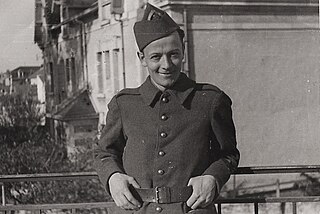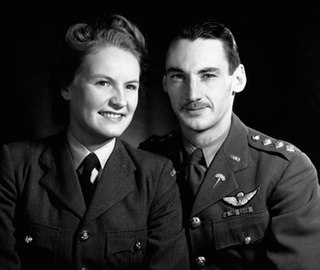
The Office of Strategic Services (OSS) was an intelligence agency of the United States during World War II. The OSS was formed as an agency of the Joint Chiefs of Staff (JCS) to coordinate espionage activities behind enemy lines for all branches of the United States Armed Forces. Other OSS functions included the use of propaganda, subversion, and post-war planning.
Special Operations Executive (SOE) was a British organisation formed in 1940 to conduct espionage, sabotage and reconnaissance in German-occupied Europe and to aid local resistance movements during World War II.
Sabotage is a deliberate action aimed at weakening a polity, government, effort, or organization through subversion, obstruction, demoralization, destabilization, division, disruption, or destruction. One who engages in sabotage is a saboteur. Saboteurs typically try to conceal their identities because of the consequences of their actions and to avoid invoking legal and organizational requirements for addressing sabotage.

Bomb disposal is an explosives engineering profession using the process by which hazardous explosive devices are disabled or otherwise rendered safe. Bomb disposal is an all-encompassing term to describe the separate, but interrelated functions in the military fields of explosive ordnance disposal (EOD) and improvised explosive device disposal (IEDD), and the public safety roles of public safety bomb disposal (PSBD) and the bomb squad.

Brian Julian Warry Stonehouse MBE was an English painter and Special Operations Executive agent during World War II. He was born in Torquay, England and had a brother, Dale. When his family moved to France, he went to school in Wimereux, Pas-de-Calais. Back in Britain in 1932, he studied at the Ipswich School of Art.

Camp X was the unofficial name of the secret Special Training School No. 103, a Second World War British paramilitary installation for training covert agents in the methods required for success in clandestine operations. It was located on the northwestern shore of Lake Ontario between Whitby and Oshawa in Ontario, Canada. The area is known today as Intrepid Park, after the code name for Sir William Stephenson, Director of British Security Co-ordination (BSC), who established the program to create the training facility.

Operation Freshman was the codename given to a British airborne operation conducted in November 1942 during World War II. It was the first British airborne operation using Airspeed Horsa gliders, and its target was the Vemork Norsk Hydro hydrogen electrolysis plant in Telemark, Norway which produced heavy water as a by-product.

Georges Pierre André Bégué, code named Bombproof, was a French engineer and agent of the United Kingdom's clandestine organization, the Special Operations Executive (SOE). The purpose of SOE in France, occupied by Nazi Germany in World War II, was to conduct espionage, sabotage, and reconnaissance. SOE agents allied themselves with French Resistance groups and supplied them with weapons and equipment parachuted in from England.

Force 136 was a far eastern branch of the British World War II intelligence organisation, the Special Operations Executive (SOE). Originally set up in 1941 as the India Mission with the cover name of GSI(k), it absorbed what was left of SOE's Oriental Mission in April 1942. The man in overall charge for the duration of its existence was Colin Mackenzie.
A limpet mine is a type of naval mine attached to a target by magnets. It is so named because of its superficial similarity to the shape of the limpet, a type of sea snail that clings tightly to rocks or other hard surfaces.
Muriel Byck was an agent of the United Kingdom's clandestine Special Operations Executive (SOE) organization in France during World War II. She died of meningitis.

Sonya Esmée Florence Butt, also known as Sonia d'Artois, code named Blanche, was an agent of the clandestine Special Operations Executive during the Second World War. SOE agents allied themselves with groups resisting the occupation of their countries by Axis powers. The purpose of SOE was to conduct espionage, sabotage, and reconnaissance in occupied countries. The SOE supplied resistance groups with weapons and equipment parachuted in from England.

The Motorised Submersible Canoe (MSC), nicknamed Sleeping Beauty, was an underwater vehicle built by the British Special Operations Executive (SOE) during the Second World War. It was designed to enable a single frogman to sabotage enemy ships, though it would also be used for short-range reconnaissance. They were replaced by the diver propulsion vehicle after the end of the war.
Raphaël Bretton was a French set decorator. He won an Oscar and was nominated for three more in the category Best Art Direction.
Operation Josephine B was a military mission in June 1941 during the Second World War. The mission was organised jointly by the Free French and the British Special Operations Executive (SOE), together with the Royal Air Force for air drops. The operation was initially stalled by a lack of up-to-date information, but ultimately succeeded in its main objective, the destruction of an electrical transformer station in Pessac, near Bordeaux.
The Combined Military Services Museum in Maldon, Essex, was opened on 5 July 2004. It was set up by Richard Wooldridge to house a personal collection he had created over many years. A charity was established in 1996 to facilitate the funding of a museum building. A suitable property was found in 2001, a former bonded warehouse in Maldon. This underwent considerable modification to suit its new purpose. In the period of setting up the museum, the initial collection was expanded by donations and acquisitions. In 2007, a National Lottery grant was given to extend the museum to house the Donnington Historic Weapons Collection. These works were completed in November 2008.
Benjamin Hodkinson Cowburn, Croix de Guerre, Chevalier of the Legion of Honour (1909–1994), code named Benoit and Germain, was an agent of the United Kingdom's clandestine Special Operations Executive (SOE) organization during World War II. He was the creator and leader of the Tinker network which operated in the area of Troyes, France. The purpose of SOE was to conduct espionage, sabotage, and reconnaissance in countries occupied by the Axis powers, especially Nazi Germany. SOE agents allied themselves with resistance groups and supplied them with weapons and equipment parachuted in from England.

Wanborough Manor is an Elizabethan manor house on the Hog's Back in Wanborough in the Borough of Guildford, Surrey. During World War II the manor house was requisitioned by the Special Operations Executive (SOE) to train secret agents and was known as Special Training School 5 and later returned to private ownership.

The Secret Intelligence Service (SIS), commonly known as MI6, is the foreign intelligence service of the United Kingdom, tasked mainly with the covert overseas collection and analysis of human intelligence on foreign nationals in support of its Five Eyes partners. SIS is one of the British intelligence agencies and the Chief of the Secret Intelligence Service ("C") is directly accountable to the Foreign Secretary.

Michael Alfred Raymond Trotobas, code named Sylvestre and known in France as Capitaine Michel, was an agent of the United Kingdom's clandestine Special Operations Executive (SOE) organization during World War II in France. The purpose of SOE was to conduct espionage, sabotage, and reconnaissance in countries occupied by the Axis powers, especially Nazi Germany. SOE agents allied themselves with resistance groups and supplied them with weapons and equipment parachuted in from England.













